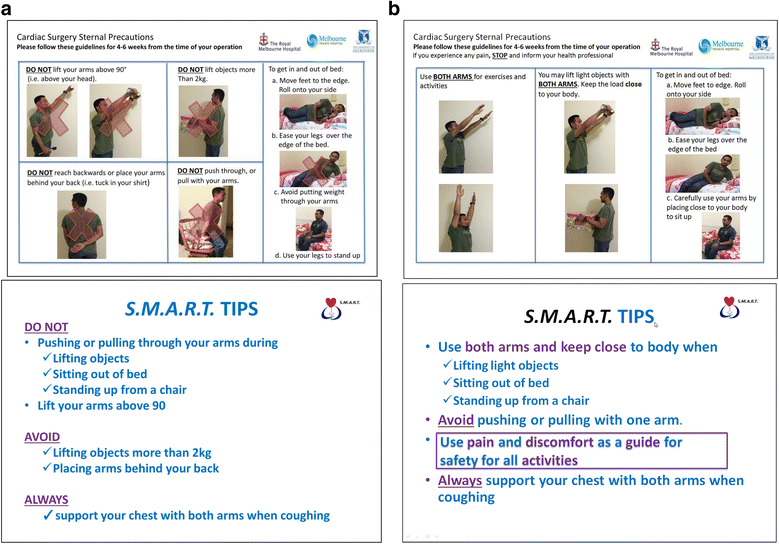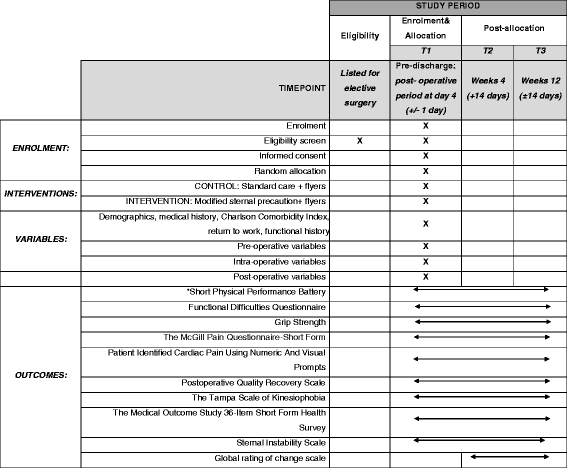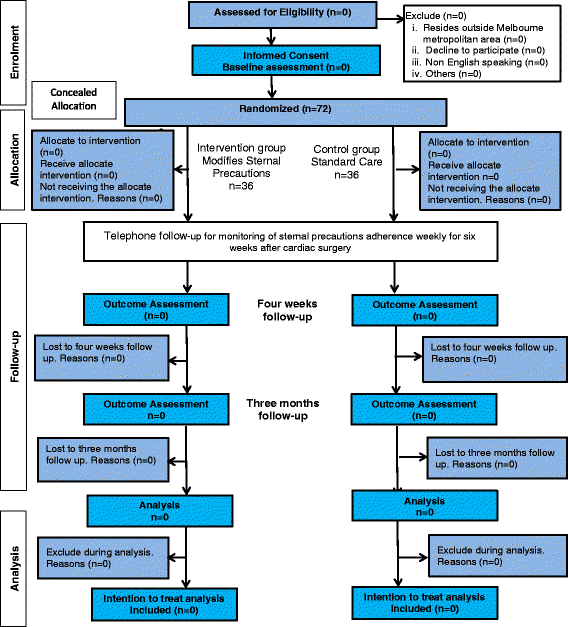The Sternal Management Accelerated Recovery Trial (S.M.A.R.T) - standard restrictive versus an intervention of modified sternal precautions following cardiac surgery via median sternotomy: study protocol for a randomised controlled trial
- PMID: 28645301
- PMCID: PMC5481951
- DOI: 10.1186/s13063-017-1974-8
The Sternal Management Accelerated Recovery Trial (S.M.A.R.T) - standard restrictive versus an intervention of modified sternal precautions following cardiac surgery via median sternotomy: study protocol for a randomised controlled trial
Abstract
Background: The routine implementation of sternal precautions to prevent sternal complications that restrict the use of the upper limbs is currently worldwide practice following a median sternotomy. However, evidence is limited and drawn primarily from cadaver studies and orthopaedic research. Sternal precautions may delay recovery, prolong hospital discharge and be overly restrictive. Recent research has shown that upper limb exercise reduces post-operative sternal pain and results in minimal micromotion between the sternal edges as measured by ultrasound. The aims of this study are to evaluate the effects of modified sternal precautions on physical function, pain, recovery and health-related quality of life after cardiac surgery.
Methods/design: This study is a phase II, double-blind, randomised controlled trial with concealed allocation, blinding of patients and assessors, and intention-to-treat analysis. Patients (n = 72) will be recruited following cardiac surgery via a median sternotomy. Sample size calculations were based on the minimal important difference (two points) for the primary outcome: Short Physical Performance Battery. Thirty-six participants are required per group to counter dropout (20%). All participants will be randomised to receive either standard or modified sternal precautions. The intervention group will receive guidelines encouraging the safe use of the upper limbs. Secondary outcomes are upper limb function, pain, kinesiophobia and health-related quality of life. Descriptive statistics will be used to summarise data. The primary hypothesis will be examined by repeated-measures analysis of variance to evaluate the changes from baseline to 4 weeks post-operatively in the intervention arm compared with the usual-care arm. In all tests to be conducted, a p value <0.05 (two-tailed) will be considered statistically significant, and confidence intervals will be reported.
Discussion: The Sternal Management Accelerated Recovery Trial (S.M.A.R.T.) is a two-centre randomised controlled trial powered and designed to investigate whether the effects of modifying sternal precautions to include the safe use of the upper limbs and trunk impact patients' physical function and recovery following cardiac surgery via median sternotomy.
Trial registration: Australian and New Zealand Clinical Trials Registry identifier: ACTRN12615000968572 . Registered on 16 September 2015 (prospectively registered).
Keywords: Cardiac Surgery; Median Sternotomy; Physiotherapy; Randomised controlled trial; Sternal Precautions.
Figures



References
-
- Windecker S, Kolh P, Alfonso F, Collet JP, Cremer J, Falk V, et al. 2014 ESC/EACTS Guidelines on myocardial revascularization: the Task Force on Myocardial Revascularization of the European Society of Cardiology (ESC) and the European Association for Cardio-Thoracic Surgery (EACTS): developed with the special contribution of the European Association of Percutaneous Cardiovascular Interventions (EAPCI) Eur Heart J. 2014;35(37):2541–2619. doi: 10.1093/eurheartj/ehu278. - DOI - PubMed
Publication types
MeSH terms
Associated data
LinkOut - more resources
Full Text Sources
Other Literature Sources
Medical

